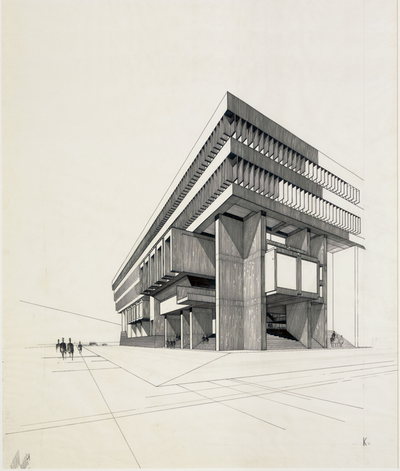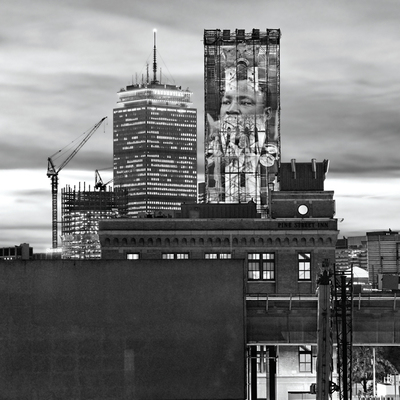Beyond City Hall
Michael McKinnell in his studio. Photo: Debbie Hagan.
A few years ago, Michael McKinnell happened to be in downtown Rockport, MA, picking up a painting he’d had framed, when he spotted his friend, art dealer Amnon Goldman, standing on the porch of Mercury Gallery. On a whim, he trotted over and joked, “This is your last chance before my show at the Whitney.”
Goldman had no idea McKinnell—who he’d known for many years as an avid art collector, then as an architect and designer of Boston’s City Hall—was a painter. He took a good look at the still life he held before him: intriguing geometric shapes, flattened picture plane and a strong presence of the artist’s hand and materials.
“Wow, this is fabulous,” Goldman remembers saying.
McKinnell remembers it slightly differently: Goldman explained that he didn’t show many living artists, mostly very high-end 1930s New York expressionists.
Both men agree, however, by the time McKinnell drove to his home and studio on Pigeon Cove, his phone was ringing. Goldman wanted to know when he could drop by.
“I love how the concepts of this architect are reflected in his art,” says Goldman. “The more I look at his works, the more I like them.”
Apparently he liked them a lot, because he remembers when he placed the first one on the wall: He had to take down an Adolph Gottlieb to hang a Michael McKinnell.
On a blustery January day, McKinnell, with his round tortoiseshell glasses, puffs of white hair over his ears and a crewneck sweater full of holes, paints in his large, light-filled studio that overlooks the ocean. He recently added this room to create a double studio for himself and his wife, Stephanie Mallis, who is also an artist and architect. Stacks of painted canvases line the room as McKinnell prepares for his upcoming show at Mercury Gallery. His paintings will hang alongside Phillip Jones’s photographs of interiors in Boston City Hall and Deborah Epstein’s weavings.
Even though McKinnell has lived in the US for more than 50 years, he’s still distinctly British—charming manners, rounded vowels and tea in the afternoon with fruity cake (baked himself). Congenial and reserved, he’s just the opposite of the person one expects from a leader of brutalist architecture.
Goldman describes him as “feisty,” and while that’s not how McKinnell comes across during a casual meeting, one might imagine it would take such a temperament to win his first big architectural job. In 1962, McKinnell was just 26 and Gerhard Kallmann, 47, when they entered a competition to build Boston’s new city hall. The city sought fresh talent and new ideas, because city leaders hoped this building would lead to a new start for Boston, beleaguered in the 1950s with crime, urban flight, corruption and a host of economic troubles. Scollay Square had been razed, leaving a gaping hole west of Faneuil Hall, which would be the site of new state and federal buildings, courthouses, a transportation hub and a new city hall.
“Competitions are great for fostering new talent,” reflects McKinnell, who saw this as a way he and Kallmann could make a dramatic architectural statement. McKinnell, a graduate student at Columbia University, and Kallmann, his friend and a Columbia professor, both greatly admired European architects such as Le Corbusier. They disdained slick steel skyscrapers clad in glass or travertine. They wanted to make a building of exposed concrete—not necessarily pretty, but authentic and honest in its structure and materials. Concrete designs such as this, had been called “brutalist,” (derived from the French term béton brut, which literally means “raw concrete”).
Top: Michael McKinnell, Quarry Triptych, oil on panel, three 24 x 24″ panels. Bottom: Perspective drawing by Michael McKinnell of Boston City Hall from the first stage of the 1961 nationwide design competition. Ink and graphite on vellum with graphite emendations. Collection of Historic New England.
Philosophically Kallmann and McKinnell thought the solid concrete structure would represent stability—a dependable, rock solid government, that would endure the ages (certainly this building would, because it would practically take an atomic bomb to remove it.) Being the seat of local government, they wanted it to be accessible and transparent, with a big open space in the middle and a hard surface plaza for big celebrations.
Local businessmen and architects—not politicians—juried the applicants. In the end, Kallmann and McKinnell (with Edward Knowles, a Manhattan architect who had a license) unanimously won.
On display at the MFA, the new city hall model shocked and stunned locals. No one had seen a building like that before. Some said it looked like an Aztec gas station. Others described it as a pigeon cage. Though the city was not obligated to construct this innovative design, “Mayor John Collins, who I think was a great mayor, agreed to do it,” says McKinnell.
On the eve of the building’s opening in 1969, Ada Louise Huxtable, in the New York Times, wrote, “It is one of the handsomest buildings around, and thus far, one of the least understood.… It is a product of these moments and these times—something that can be said of successful art of any period.”
Fifty years later, City Hall remains much loved and much scorned. Former Mayor Thomas Menino growled incessantly about tearing it down, and on the campaign trail for the mayoral seat, Marty Walsh promised to sell it off.
“I believe he has altered his view slightly,” says McKinnell. “It’s like any art. When it’s first made, there’s the excitement, the shock of the new. Then people get used to it.” This is true. Public interest in modernist structures has recently dramatically risen (see “Age of the Modern Home”). There’s more effort now to visit, restore and even save these buildings.
The architectural community has always praised Boston’s City Hall and honored the architects and their firm Kallmann McKinnell & Wood with awards. They’ve gone on to complete highly acclaimed projects, such as Boston Five Cents Savings Bank, Hynes Convention Center and American Academy of Arts & Sciences. In 1976, when the American Institute of Architects asked distinguished architects, critics and historians to name the best buildings in US history, Boston City Hall was tied with Trinity Church for seventh place. When asked to pick the best building designed by living architects, their top choice was Boston City Hall.
It’s this conscious use of materials and process that distinguishes modernism, which just happens to be one of the key links between McKinnell’s buildings and his paintings. “In architecture, I’ve always been interested in materials, showing how the stuff is formed,” he says. Likewise in his paintings, he exposes the paint, the brushstrokes, even the canvas.
“As with Georges Braque’s paintings, I mix sand and dirt in them,” he says. “I make the painting to be an autonomous thing unto itself. It’s like the rocks you see. I love the rocks by the sea. They’re worked over—some smooth, some rough.” He recreates that idea on the canvas, varying texture, abrading the surface.
Last summer McKinnell exhibited a series of paintings in an exhibit called Cape Ann Quarries—landscapes with giant stones in the foreground and the calm, beautiful sea in the background. The exposed rawness of the materials, the strength implied by the stout and seemingly solid shapes in contrast to the smoothness of the grass or sea, are strikingly reminiscent of McKinnell’s buildings, particularly City Hall.
“The quarry exhibit was about the intervention of man—nature transformed,” he says. Now that he’s spending more time in his studio in Rockport, an area rich with rocks, boulders and quarries, McKinnell delights in seeing houses made of stone or walls constructed from collected rocks—“it’s nature that’s been transformed by man’s hand.”
This day, five paintings in various stages of completion are perched on easels in McKinnell’s studio. They’re strikingly different from his previous landscapes or still lifes. Notably, he’s no longer using earth tones, but much bolder colors, predominately red. He’s far less representational, and his subjects are more geometric with interlocking, possibly quarry shapes. “Before, I was more conscious of representing rocks and a sense of landscape, but I’ve become more aware of the fact of painting a parallel that’s related rather than being an illusion of reality,” he says.
In May, he’ll show these paintings with a weaving, inspired by City Hall, by artist and architect Deborah Epstein, and photographs by Phillip Jones. Known for his ability to capture ordinary scenes and structures in somewhat magical ways, Jones is a fan of Boston’s City Hall, calling it “extraordinary.” About two years ago, when Jones installed an exhibit of Boston cityscapes in the Mayor’s Gallery, he explored some of City Hall’s less public corridors and atriums. “Some of the spaces reminded me of modern versions of Piranesi’s engravings of interiors,” he says. “Others seemed to have the extra angles of an M. C. Escher drawing.” Jones hopes to photograph them for the Mercury show.
Top: Deborah Epstein, Quarry Rug with Snow, 2012, wool, alpaca, silk, linen, cotton, mohair, 42 x 66½”. Photo: Alan Joslin. Bottom: Phillip Jones, Boston Towers: MLK, 2015, photograph on aluminum ed:1/10, 30 x 30″. Courtesy of Mercury Gallery.
“He’s a very good photographer,” says McKinnell, who is eager to see Jones’s work.
As for his own art, people often will ask him, “Have you been an artist all your life?” It’s a question that usually takes him aback “You wouldn’t ask that of Michelangelo,” McKinnell says. The answer is yes. He has been making art since he was a boy attending grammar school in Manchester, England. He says, “It’s all art. It’s a way of life.”
Debbie Hagan is editor-in-chief of Art New England.





